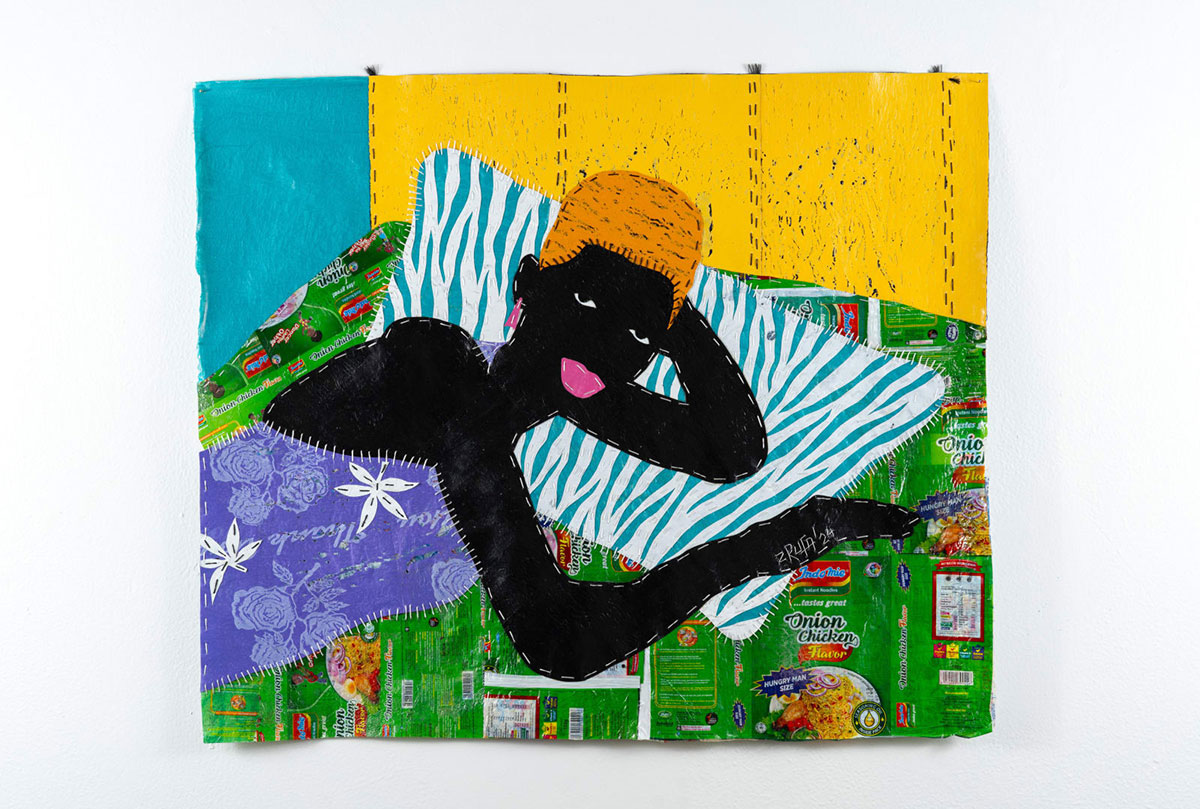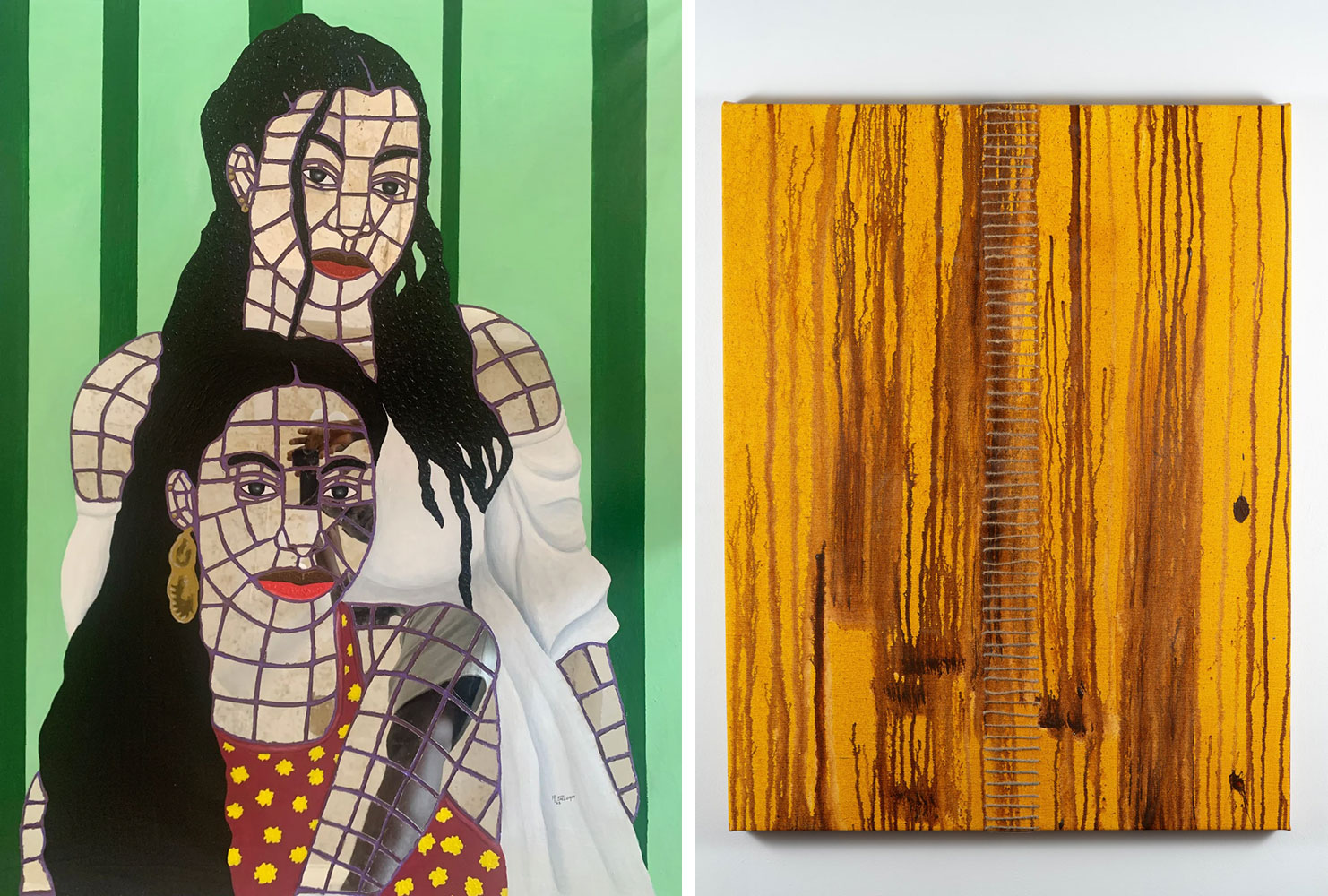PRESENTATION: A Gentle Seed
 The story of how the exhibition “A Gentle Seed” begins with how Jill McLennon, founder of McLennon Pen Co. Gallery, first met Rufai Zakari. One of the leading artists in Ghana, Zakari graciously agreed to his request to visit his studio in Accra in the summer of 2021. It is worth noting he also has a second studio in Bawku, his hometown, because he goes back and forth between the two places– maintaining his roots and giving back to his community but also being an active participant in the rich art scene in the Nima neighborhood of Accra, the capital and largest city in Ghana.
The story of how the exhibition “A Gentle Seed” begins with how Jill McLennon, founder of McLennon Pen Co. Gallery, first met Rufai Zakari. One of the leading artists in Ghana, Zakari graciously agreed to his request to visit his studio in Accra in the summer of 2021. It is worth noting he also has a second studio in Bawku, his hometown, because he goes back and forth between the two places– maintaining his roots and giving back to his community but also being an active participant in the rich art scene in the Nima neighborhood of Accra, the capital and largest city in Ghana.
By Dimitris Lempesis
Photo: McLennon Pen Co. Gallery Archive
The street facade of Zakari’s Nima studio, housed in a former beauty salon, is adorned with colorful still advertisements of women posed wearing glamorous makeup and head wraps. This is a fun and engaging prelude to the eruption of color and personality found in Zakari’s bold figurative artworks within the studio. His chosen materials of single-use plastics such as plastic bags, food packaging, and water sachets have been collected from the streets, washed, and flattened by a hot press and then neatly organized onto the studio shelves–a color palette entirely made from trash. Zakari aims to call attention to the implications of discarded plastics and to find beauty in what people think of as rubbish. Cutting and sewing together plastic sheets, Zakari forms colorful figurative artworks portraying members of his community. The participating artists are: Selorm Amekorfia is a multidisciplinary artist from Accra, Ghana. Amekorfia was mentored by the same artist as Rufai Zakari, a man named Hashim Hussein that has been nicknamed “Mozzay,” or the “grandpa of art.” Amekorfia draws inspiration from personal and societal experiences through his unique medium of broken mirrors and acrylic paints. He believes art is a tool for healing and communication, each vibrant color represents people going through things they find difficult to overcome. His works delves into identity and reincarnation. Amekorfia describes his inspiration saying “sometimes we fail and cry, sometimes we feel lonely and sad. But don’t ever forget there is beauty and value behind your broken self. Be strong, pick up the pieces and reshape it into a greater version of yourself”. Theresah Ankomah is a Ghanaian artist born in Kokomlemle who lives and works in Accra. She works in various mediums ranging from painting, printmaking, installation, performance, fashion, and weaving. Many of her projects begin with basket weaving, used as a viewfinder to investigate the complexities of craft by abstracting and experimenting with memory-holding objects and materials. Ankomah has a socially engaged practice and purposefully focuses on issues of labor and consumerism. Her practice observes, defies, conflates, and interrogates everyday objects to explore moments of transformation, community, intimacy, and family. Kwabena Fordjour is an artist who currently resides at La in the Greater Accra Region of Ghana. His research centers on the transportation culture prevalent among his community, exploring its multifaceted impact on time management, individual productivity, and Ghana’s economic landscape. He delves into a range of transportation queue systems, monologues, dialogues, and human interactions observed within the movement of vehicles. Through these narratives, he crafts stories depicting the everyday Ghanaian’s utilization of time during their commutes from one place to another. He draws inspiration from commuting, vehicular motions, and human attitudes. His acrylic vibrant color dab and patch technique works are inspired by great masters like Vincent Van Gogh and Claude Monet. Salihu Mohammed is an artist from Accra, Ghana. In his painting practice he navigates the intersection of the known and the unknown, delving into themes of identity and self-exploration using symbolism and visual metaphors. Mohammed values narratives that illuminate overlooked individuals and their stories, often people in his community ranging from women he admires to children filled with curiosity. His body of work often wrestles with the intricate challenge of harmonizing cultural identity with the constantly shifting demands of contemporary life. Daniel Tetteh Nartey is a Ghanaian pop-surrealist artist who juxtaposes the human body in fragments, incorporating heads, hands, and legs as recurring motifs that emphasize the multifaceted nature of human relationships and communalism. Utilizing acrylics and oils on canvas, he skillfully distorts the human form, employing it as a powerful symbol for societal frameworks and individualism. This prompts discussions about the importance of embracing personal uniqueness within the framework of collective unity, encouraging viewers to ponder the harmonious coexistence of diverse identities. In his artwork, the color blue emerges as a recurring visual thread, symbolizing peace, universality, and fluidity. This pigment infuses his subjects with a meditative sense of tranquility, serving as a poignant reminder of our shared humanity. Amina-Toure is a Ghanaian-born and raised figurative painter who currently lives and works in Columbus, Ohio, USA. She has an MFA in Painting and Drawing from Ohio University. Toure’s work is grounded in community engagements as she is fascinated by human interactions and relationships. She seeks to explore and visually represent stories around the coping behaviors of African diaspora populations in the United States. She paints people from her local African immigrant community in Columbus as she seeks to shed light on their efforts and struggles to create a sense of home and belonging in their new environments. Amina works primarily with oils and acrylics. She also employs image transfers and collages of “Ghana must go Bags” which have for long been used as a symbol of immigration and transition. Rufai Zakari splits his time between Accra and Bawku, Ghana. His figurative works are made from discarded single-use plastics gathered from the streets of his home country of Ghana. In crafting his loving portraits from trash, Zakari seeks to examine the roles that consumerism, pollution, labor, and industrialization play in contemporary Ghanaian society. Zakari graduated from Ghanatta College of Art and Design in Accra in 2011, the same school where some of his esteemed Ghanaian peers, including Amoako Boafo, Otis Kwame Kye Quaicoe, and Kwesi Botchway, also studied. He apprenticed under the Accra-based street artist known as “Mozzay.”
Participating Artists: Selorm Amekorfia, Theresah Ankomah, Kwabena Fordjour, Salihu Mohammed, Daniel Tetteh Nartey, Amina-Toure, and Rufai Zakari.
Photo: Rufai Zakari, A MOMENT WITH THY SELF, 2024, 28 x 33 3/4 inches, © Rufai Zakari, Courtesy the artist and McLennon Pen Co. Gallery
Info: McLennon Pen Co. Gallery, 2502 East 12th Street, Austin, TX, USA, Duration: 8/3-20/4/2024, Days & Hours: Wed-Sat 12:00-18:00, https://mclennonpenco.com/


Right: Salihu Mohammed, The In-between, 2023, Mixed media, 37 1/2 x 27 1/2 inches, © Salihu Mohammed, Courtesy the artist and McLennon Pen Co. Gallery


Right: Theresah Ankomah, Asaase Akwa, 2022, Acrylic paint and jute rope stitches on canvas, 36 x 28 inches, © Theresah Ankomah, Courtesy the artist and McLennon Pen Co. Gallery
